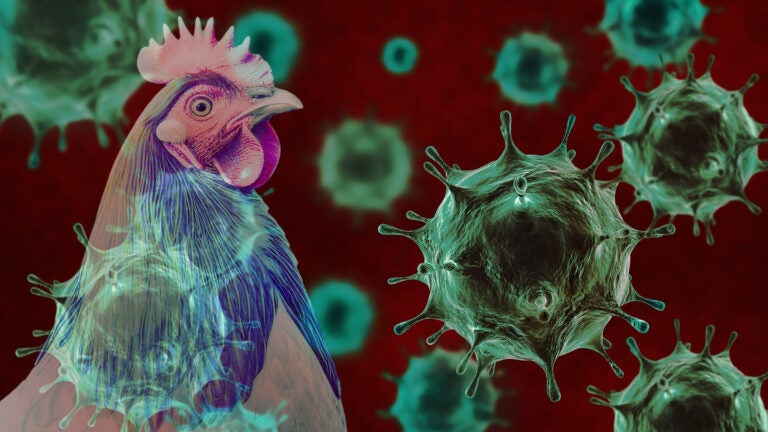
Since 2022, bird flu has infected nearly 7 million commercial and backyard chickens in the United States. (Photo illustration/iStock)
Bird flu: Is it time to worry?
The outbreak’s impact will likely be felt in grocery prices, including the cost of your Thanksgiving bird, and across supply chains. And get your flu shot, too, just to be safe.
Bird flu is spreading just as Americans are planning their various holiday dinners that for many involve platters of turkey, goose or other poultry, and various pies, puddings and cakes made with eggs.
The Centers for Disease Control and Prevention believes the risk of it infecting humans is low. But its impact on your pocketbook could be high, USC experts say.
Since 2022, bird flu — widespread in wild birds — has infected nearly 7 million commercial and backyard chickens in the United States. In March, the H5N1 virus was detected for the first time in dairy cattle, and it has sickened some dairy farmworkers. The nation’s leading dairy producing state, California, is at the epicenter the dairy cattle outbreak.
“It’s poised to disrupt supply chains, particularly in the poultry industry, leading to higher prices and possible shortages of poultry products,” said Nick Vyas, founding director of the Randall R. Kendrick Global Supply Chain Institute and an associate professor of clinical data sciences and operations at the USC Marshall School of Business. “We’ve seen how these situations can escalate. In 2022, the outbreak led to skyrocketing egg prices and substantial losses as millions of birds were culled.
“What’s particularly worrying this time is that H5N1 isn’t just affecting poultry — it’s hitting dairy cattle, too. This development underscores how interconnected our food supply chains are and how vulnerable they can be to such outbreaks. Controlling the virus must be practical to safeguard public and animal health, prevent further food availability disruptions and keep prices stable.”
How bird flu could affect Thanksgiving and inflation
The CDC is on watch for whether the virus may jump to other species or develop the ability to spread person-to-person — a shift that would trigger worldwide alarm. The CDC is using its flu surveillance systems to monitor for H5 bird flu activity in people.
For now, the most immediate impact could be on the cost of your holiday dinner. Somya Singhvi, an assistant professor of data sciences and operations at USC Marshall, said we might see a shift toward substitutes, such as plant-based proteins, potentially increasing their prices.
“Retailers may also face operational challenges in reallocating shelf space and managing inventory, further impacting pricing and product availability,” Singhvi said. “Overall, the outbreak could create a ripple effect across various food categories, leading to broader inflation in grocery prices.”
Bird flu could mix with human flu
There have been 46 confirmed human cases in the United States during the this year’s outbreak, reported in California, Colorado, Michigan, Missouri, Texas and Washington state, according to the CDC. There’s been no confirmed person-to-person spread.
The case of a critically ill teenager in British Columbia — Canada’s first detected human case of domestically acquired H5N1 — is in the headlines, but genetic tests showed it is a strain found in wild birds and different from the one circulating in cows.
One way to help prevent a human pandemic is to get your flu shot, said Richard Dang, an assistant professor of clinical pharmacy at the USC Alfred E. Mann School of Pharmacy and Pharmaceutical Sciences. That’s because two different influenza viruses can infect the same person, or animal, at the same time, allowing their genes to mix and create a new virus.
“While a human vaccine for bird flu is not currently available, it is important to prevent co-infections with human influenza viruses by receiving the influenza vaccine,” Dang said. “Through careful monitoring, vaccination and other precautionary measures, we can mitigate this emerging health threat before it turns into another pandemic.”



